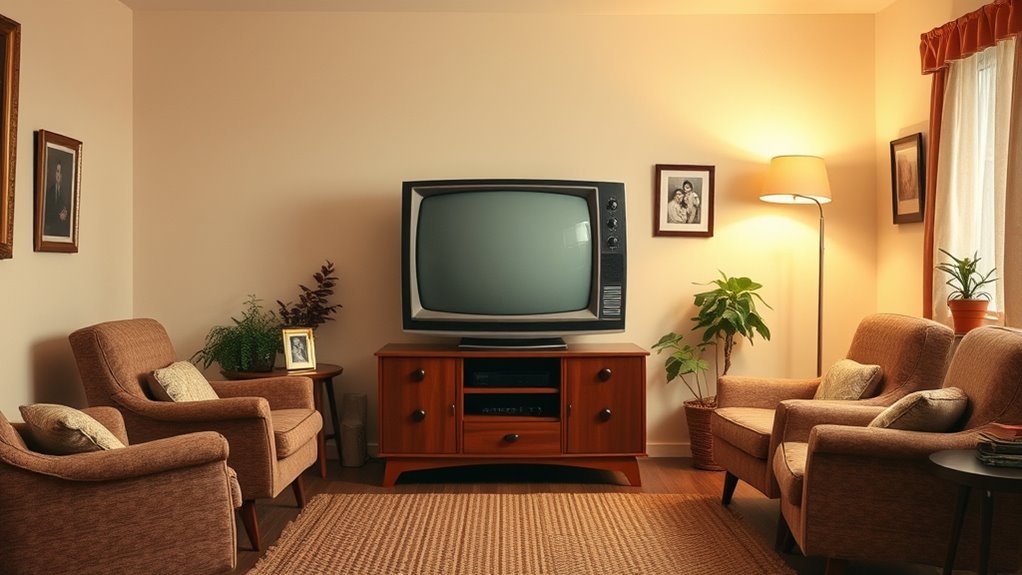When TVs were furniture, they became the focal point of your living room, blending style with functionality. Vintage designs featured wooden cabinets, bold colors, and intricate craftsmanship, transforming the TV into a statement piece. Over time, technology advanced, leading to sleek, space-saving, wall-mounted screens that integrated seamlessly into modern decor. This shift changed how you organize your space and socialize, setting the stage for even more innovative designs you’re about to discover.
Key Takeaways
- Vintage TVs were often integrated into furniture, such as wooden cabinets, blending technology with home decor.
- The shift to sleek, wall-mounted designs transformed televisions into minimalist, space-saving focal points.
- TV placement influenced living room layouts, promoting social interaction and centralizing entertainment areas.
- Modern trends favor hidden wiring and multifunctional furniture, maintaining aesthetics while enhancing functionality.
- The evolution from bulky furniture-style TVs to slim screens reflects changing lifestyles and technological advancements.
The Rise of the Furniture-Style Television
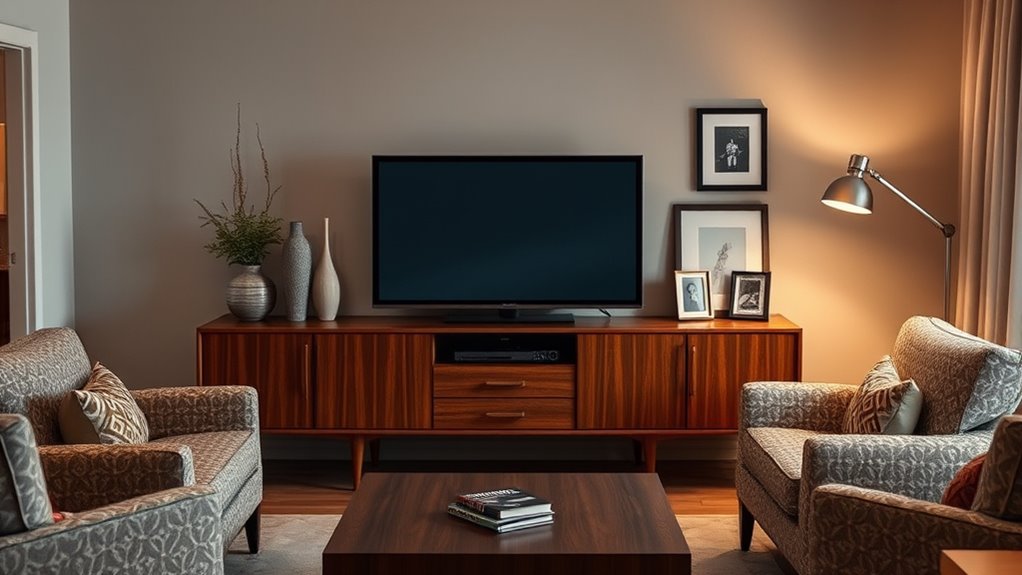
As television designs evolve, furniture-style TVs have become increasingly popular, seamlessly blending technology with home decor. These units often feature retro styling that echoes mid-century aesthetics, appealing to those who appreciate vintage branding. Their sleek, integrated look transforms a bulky screen into a stylish furniture piece, making them ideal for modern living rooms. The retro design elements evoke nostalgia, while the vintage branding adds a sense of authenticity and character. You’ll notice how these TVs serve not just as entertainment hubs but as statement furniture pieces that enhance your space’s overall vibe. By combining functionality with timeless style, furniture-style TVs redefine what it means to have a television in your living room. They turn a simple screen into a curated design feature.
Design and Material Choices in Vintage TVs
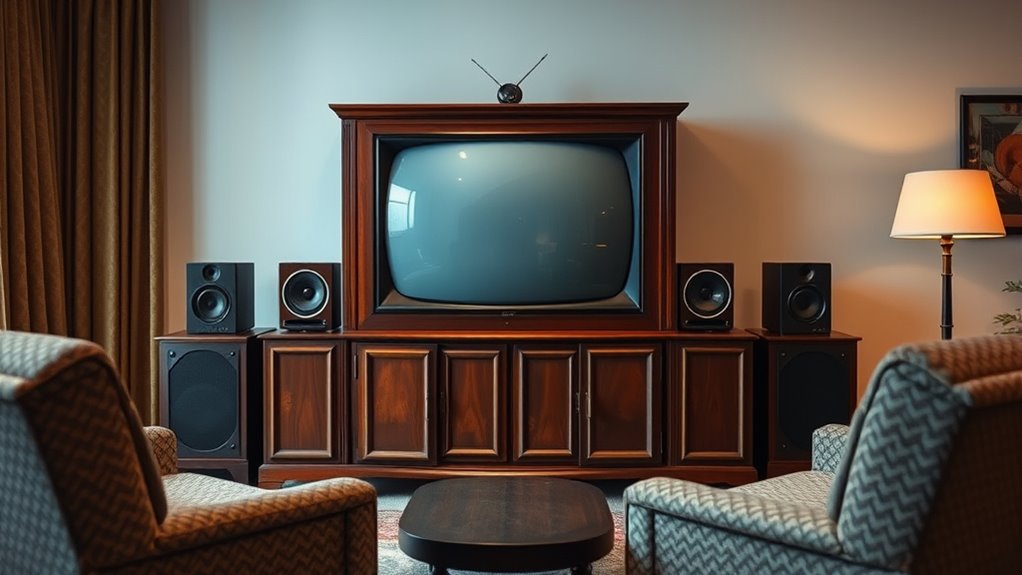
Vintage TVs often feature wooden cabinets that add warmth and charm to your living space. You’ll notice their classic color palettes, which range from muted tones to bold hues, reflecting the style of their era. Considering material durability helps guarantee your vintage TV remains a functional and attractive piece for years to come. Incorporating material preservation techniques can further enhance their longevity and maintain their aesthetic appeal.
Wooden Cabinet Aesthetics
The wooden cabinets of vintage TVs stand out for their craftsmanship and timeless appeal. You notice how the wooden cabinetry adds warmth and character, blending seamlessly into your living room decor. These cabinets often feature rich finishes, intricate grain patterns, and elegant details that elevate the TV from a simple electronic device to a piece of furniture. The choice of wood enhances the aesthetic appeal, giving the television a classic, high-quality look. You might appreciate the sturdy construction and smooth surfaces, which reflect the craftsmanship of the era. The natural beauty of the wood complements various interior styles, making vintage TVs more than just technology—they become statement pieces that add charm and sophistication to your space.
Vintage Color Palettes
Have you ever noticed how the color choices of vintage TVs instantly set a nostalgic tone in a room? These TVs often feature bold, vibrant hues like turquoise, avocado green, or cherry red, which create striking color harmony with surrounding decor. The vintage styling emphasizes these palettes with smooth curves and glossy finishes, enhancing their visual appeal. The carefully selected colors weren’t just about aesthetics—they reflected popular trends of their era and aimed to evoke warmth and familiarity. You might find that these color options make your living space feel cozy and inviting. When integrating vintage TVs, choosing complementary colors helps maintain the authentic retro vibe. Additionally, understanding color psychology can guide you in selecting hues that evoke specific moods in your space. Overall, the color palettes in vintage TVs play a vital role in defining their unique charm and nostalgic appeal.
Material Durability Factors
While many vintage TVs are celebrated for their nostalgic charm, their durability largely depends on the design and materials used during manufacturing. The material resilience of components determines how well the TV withstands time and use. Surface finishes also play a vital role in protecting the exterior from scratches and fading. Consider these factors:
- Cabinet Materials: Bakelite, wood veneer, or metal frames offer varying resilience levels.
- Plastic Components: Quality plastics resist cracking and discoloration with age.
- Surface Finishes: Glossy or matte finishes impact scratch resistance and aesthetic longevity.
- Internal Components: Durable wiring and robust circuitry prevent early failure and extend lifespan.
In addition, proper material selection during the design process can significantly influence the vintage TV’s overall durability and appearance.
Choosing materials with high resilience and well-applied surface finishes ensures your vintage TV remains a functional and attractive centerpiece.
Integration of TV Into Home Décor
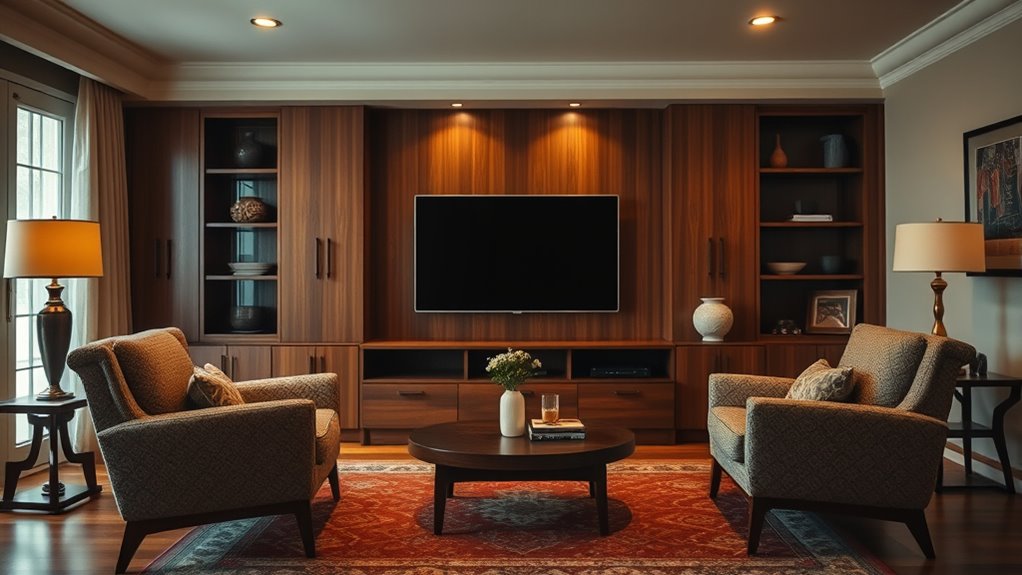
Integrating a TV into home décor requires thoughtful planning to guarantee it complements rather than disrupts your space. To achieve this, consider styles like art deco motifs or vintage upholstery, which add character and harmony. Use furniture that blends aesthetic appeal with functionality, such as sleek cabinets or floating mounts. Incorporate decorative elements around your TV to make it feel intentional. Here’s a quick guide:
| Style | Approach | Tips |
|---|---|---|
| Art Deco Motifs | Incorporate geometric details | Use metallic accents or bold patterns |
| Vintage Upholstery | Pair with retro furniture | Opt for plush, textured fabrics |
| Mounting Options | Conceal cords and cables | Choose low-profile mounts |
| Color Palette | Match with room’s hues | Use neutral or complementary shades |
| Accessories | Decorate around the TV | Add art, plants, or books |
Additionally, integrating a leadership mindset when designing your space can help you create a balanced and inspiring environment.
The Social Impact of a Centralized Living Room
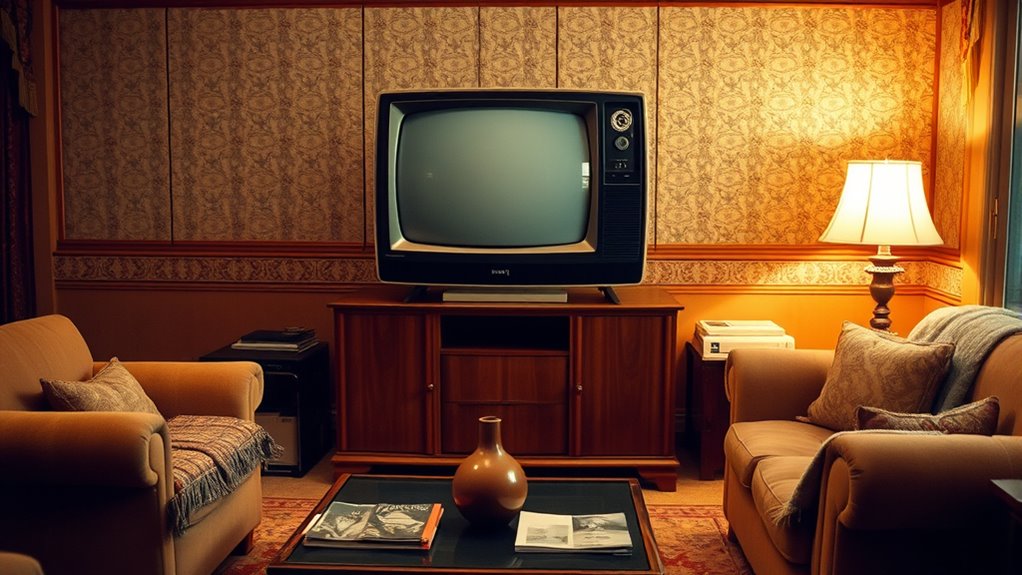
You might notice how the TV in your living room changes the way your family bonds and interacts. Social gatherings often revolve around the screen, shifting how friends and relatives connect. At the same time, your space can feel more private or crowded, depending on how it’s used.
Family Bonding Dynamics
The centralization of the living room has transformed how families interact and bond. Now, your family’s routines are more synchronized around the TV, creating shared experiences. This shift fosters stronger generational bonding by giving everyone something to connect over. Here are four ways it impacts your family dynamics:
- It encourages collective viewing, making family evenings more engaging.
- It strengthens traditions, like movie nights or sports rituals.
- It reduces informal conversations, replacing spontaneous chats with shared media.
- It creates a common space where different age groups find common ground.
Social Gathering Shifts
As families gather around the TV more frequently, the living room has become a focal point for social interactions beyond just family bonding. It’s now a space where friends are invited over to watch movies or sports, turning the TV into a social hub. This shift also encourages outdoor entertainment, as people combine outdoor activities with screen time, such as outdoor movie nights. Mobile viewing has further transformed social gatherings, allowing you to access content anywhere, making spontaneous get-togethers easier. The TV’s presence draws people together, creating shared experiences that extend beyond traditional family moments. This centralized entertainment spot fosters a sense of community within your home, making the living room a key place for socializing, whether through watching together or connecting over shared interests. Incorporating home theater projectors can further enhance this experience by delivering larger, more cinematic displays that elevate group viewing.
Privacy and Space
While the living room’s central role in social life brings people together, it also raises concerns about privacy and personal space. With the TV as the focal point, your spatial arrangements change, impacting how you interact privately. Privacy concerns arise as family members and guests gather in shared spaces, making it harder to find quiet or personal moments. Here are some ways this shift affects you:
- Open layouts reduce secluded areas, increasing exposure.
- Centralized seating encourages group conversations but limits privacy.
- TV viewing habits influence how space is used and divided.
- Personal boundaries may blur in shared environments, affecting comfort.
- Recognizing the social impact of the TV, such as how it alters spatial dynamics, can help you better manage your living environment.
Understanding these impacts helps you navigate the social and spatial dynamics created by the TV’s central role in your living room.
Technological Advances and Size Reduction
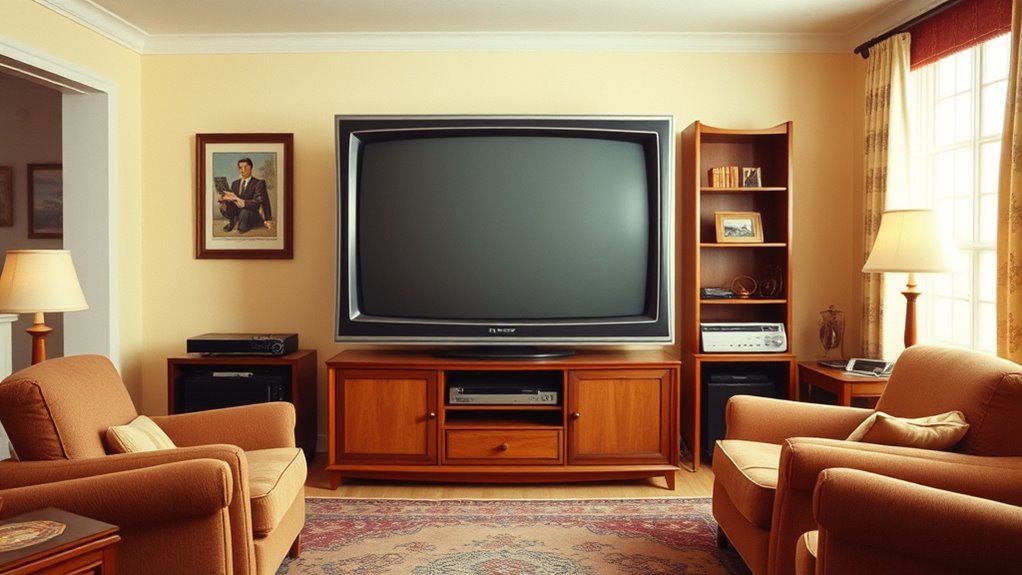
Advancements in technology have dramatically transformed televisions, making them more compact and versatile than ever before. Today’s TVs come with sleek designs that fit seamlessly into modern living rooms, no longer dominating the space like early models. Remote controls have become intuitive, offering precise navigation and easy access to features, enhancing your viewing experience. Meanwhile, improvements in screen resolutions, such as 4K and 8K, deliver stunning clarity and detail, making images sharper and more lifelike. These technological innovations have reduced the size of components without sacrificing quality, allowing TVs to be both powerful and space-efficient. As a result, you now enjoy high-quality entertainment without the bulky, furniture-like presence of the past, giving your living room a more open and contemporary feel. Additionally, smart TV features have integrated internet connectivity and app support, transforming TVs into multi-functional entertainment hubs.
Transition to Sleek and Minimalist Entertainment Centers
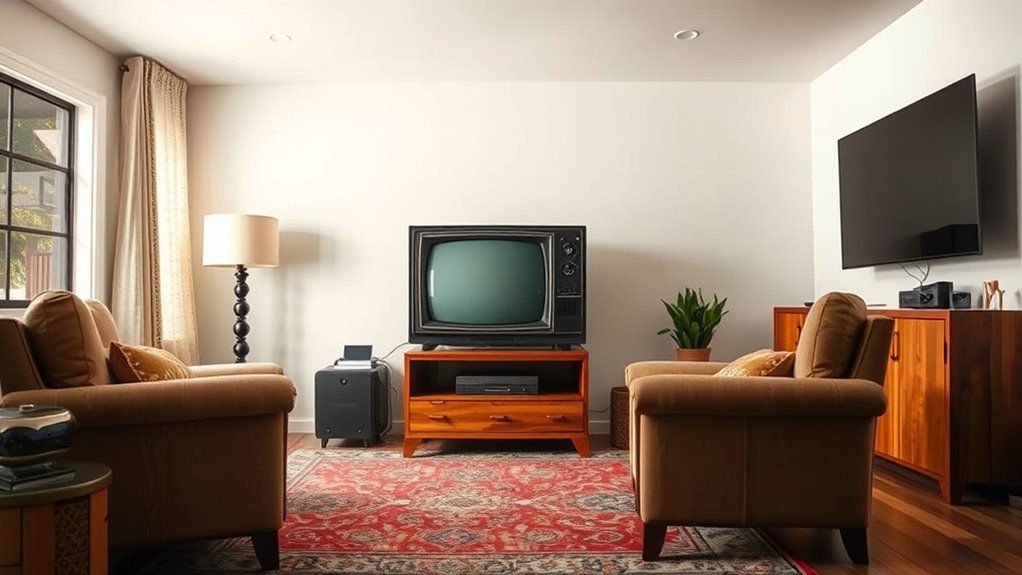
The shift toward sleek and minimalist entertainment centers reflects a broader trend of integrating technology seamlessly into the living space. You now want a clutter-free look that emphasizes clean lines and hidden storage. To achieve this, consider these key features:
- Wall-mounted TVs for a streamlined appearance.
- Concealed wiring to hide cables and streaming devices.
- Floating shelves or cabinets to reduce visual clutter.
- Integrated home theater systems that blend into the design.
- Using essential oils with calming properties can enhance the ambiance of your living area, creating a relaxing environment even within a minimalist setup.
This approach prioritizes functionality and aesthetics, making your space feel open and modern. Streaming integration is seamless, allowing you to access content without bulky equipment. These minimalist centers enhance your viewing experience while maintaining a sleek, organized environment, aligning with contemporary design trends.
Cultural Reflections of TV as a Piece of Furniture
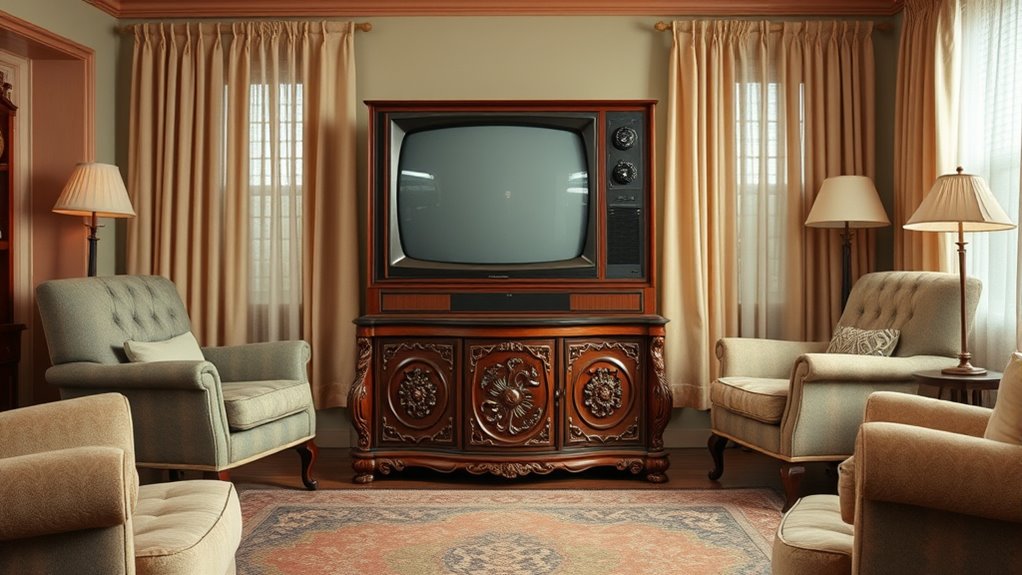
As televisions evolved from bulky boxes to sleek focal points, they began to reflect cultural values and societal shifts. You notice how media consumption habits influence the design and placement of the TV, turning it into a symbol of cultural identity. In earlier decades, the TV’s prominence in living rooms showcased the importance of shared experiences and collective entertainment. As furniture, it became a statement piece that communicated status and taste. Today, the way you incorporate the TV into your space reveals much about your cultural values and lifestyle. It’s no longer just a device for watching; it’s a reflection of societal priorities, shaping and mirroring your cultural identity through the way you display and engage with media. Incorporating natural elements into the surrounding decor can also emphasize a connection to tradition and authenticity.
The Modern Shift Toward Compact and Wall-Mounted Screens
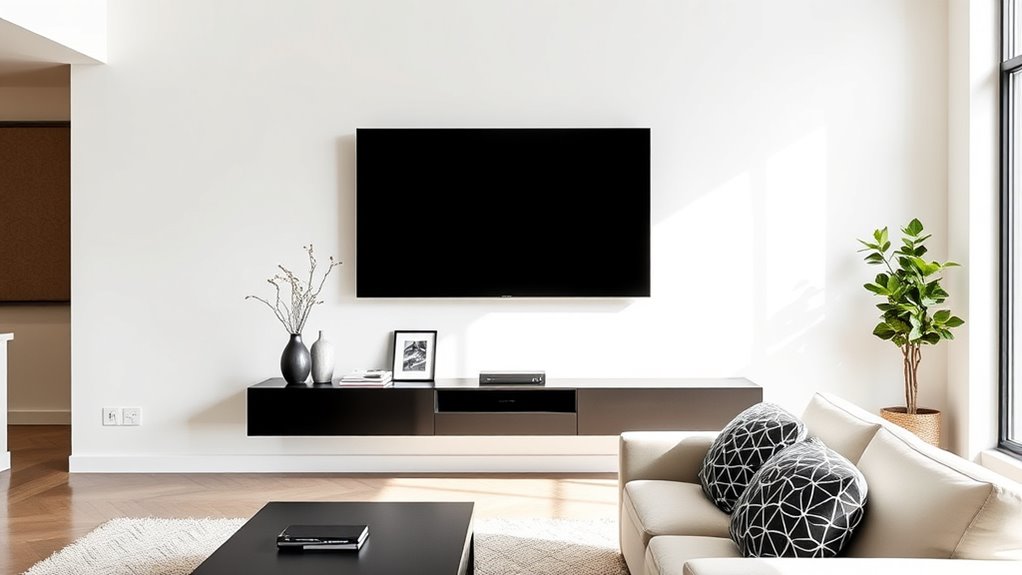
With the increasing popularity of compact and wall-mounted screens, many homeowners are rethinking their living room layouts to prioritize sleekness and space efficiency. You now see less bulky furniture and more minimalist setups. This shift includes choosing portable screens that can easily move around or fold away when not in use. Outdoor televisions are also gaining popularity, allowing you to enjoy shows outside without cluttering your space. Implementing efficient general ledger coding helps manage the financial aspects of these modern upgrades seamlessly. Here are four key trends:
Compact, wall-mounted screens and outdoor TVs create sleek, flexible, and clutter-free entertainment spaces.
- Slim, wall-mounted TVs save room and enhance modern aesthetics
- Portable screens enable flexible viewing options inside and outside
- Outdoor televisions expand entertainment spaces to patios and gardens
- Minimalist designs emphasize clean lines and unobtrusive setups
This modern approach transforms how you experience entertainment at home.
Frequently Asked Questions
How Did the Tv’s Role as Furniture Influence Interior Design Trends?
You notice that TV aesthetics have markedly influenced your living room layouts over time. As TVs became central furniture pieces, designers prioritized sleek, integrated looks, encouraging minimal clutter. You might find that modern layouts focus on balancing the TV with other decor, using custom cabinetry or wall mounts. This shift emphasizes functionality and style, shaping how you arrange furniture and choose decor to create a harmonious space centered around your television.
What Materials Were Most Popular in Vintage Television Manufacturing?
Imagine stepping into a cozy room where vintage televisions stand like proud pieces of art. You notice the vintage materials, with cabinet wood bringing warmth and elegance, like a familiar embrace. Popular manufacturing choices included sturdy Bakelite and glass screens, but the classic cabinet wood defined the era’s charm. These materials gave each television a personality, transforming it from mere tech into a statement piece in your living space.
How Did TV Placement Affect Social Interactions in the Home?
You notice that TV placement markedly influences social dynamics and family interactions in your home. When the TV is central, it often becomes the focal point, encouraging shared viewing experiences and conversations. Conversely, placing it off to the side might foster more face-to-face interactions among family members. Your choices in TV placement shape how people connect, creating either a communal space for bonding or a more isolated environment.
When Did TVS Start Being Integrated Into Custom Cabinetry?
You’ll notice that TVs started being integrated into custom cabinetry and built-in systems during the 1960s and 1970s. Manufacturers and homeowners began designing these seamless setups to hide screens when not in use, creating a cleaner look. This trend grew as technology advanced, making built-in systems more popular, and allowing TVs to blend into the living room’s decor. Today, integrated cabinetry remains a stylish way to incorporate screens into your space.
What Cultural Factors Contributed to the Tv’S Evolution as Furniture?
Imagine your family gathered around a sleek, integrated TV in the 1950s. Cultural perceptions of progress and technological optimism fueled this shift, making the TV a centerpiece of social life. You see, society believed new gadgets represented modernity. This mindset led manufacturers to design furniture that showcased TVs as stylish, essential pieces—transforming them from mere devices into integral parts of your living space and reflecting broader cultural values.
Conclusion
As you step back and look at how TVs once anchored your living room like a piece of art, you realize they’ve transformed from bulky furniture to sleek, invisible tech. Today, screens are whispers on the wall, blending seamlessly into your space like chameleons. The TV’s journey from furniture to minimalist marvel reflects how our homes and habits evolve—reminding you that even the most familiar pieces can surprise you when you look closer.
